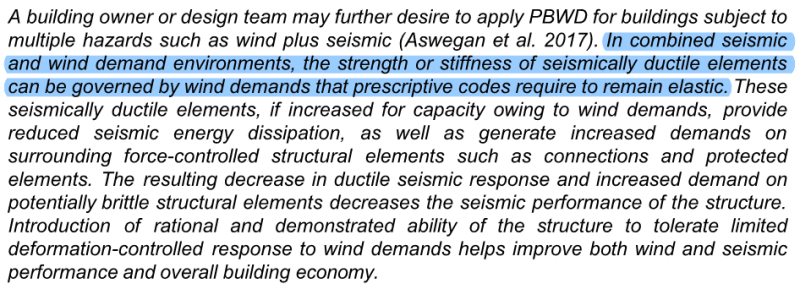Working on a 20-story building in SDC A utilizing ordinary shear walls with pretty low wind speeds (105mph). I have a strong seismic background and am used to the detailing requirements of special shear walls and boundary zones.
With that said, I've got regions in my cores that exceed the 0.2f'c that typically would require boundary zones if the walls were special, however based solely on ACI 318-19 Chapter 11, the only requirement I can find with regards to a requirement for confinement of reinforcing is 11.7.4, where if Ast >0.01AG, longitudinal reinforcement shall be laterally supported by transverse ties, which is pretty vague.
Because of the building use and egress requirements, I've actually got two concrete cores and plenty of wall from a capacity perspective (and low base shear) to the point where right now I can get by with minimum steel, even at the base, for all demands, which means I don't exceed the 0.01AG limit. Drift is driving 12" wall thicknesses. I am also seeing concrete strain limits under 0.003
Part of my understanding is that for seismic zones, buckling of bars is more likely to occur due to the violent and rapid energy transfer during a seismic event, while buildings that experience high wind loads occur over a much longer time period. However even still, it doesn't sit right with me that no confinement of reinforcing would be required.
Has anyone run into this before? Is there any guidance anywhere for boundary zones not in seismic zones? I'm leaning toward putting in confinement reinforcement where 0.2f'c is exceeded, but it doesn't make sense that there appears to be no actual code requirement for it.
With that said, I've got regions in my cores that exceed the 0.2f'c that typically would require boundary zones if the walls were special, however based solely on ACI 318-19 Chapter 11, the only requirement I can find with regards to a requirement for confinement of reinforcing is 11.7.4, where if Ast >0.01AG, longitudinal reinforcement shall be laterally supported by transverse ties, which is pretty vague.
Because of the building use and egress requirements, I've actually got two concrete cores and plenty of wall from a capacity perspective (and low base shear) to the point where right now I can get by with minimum steel, even at the base, for all demands, which means I don't exceed the 0.01AG limit. Drift is driving 12" wall thicknesses. I am also seeing concrete strain limits under 0.003
Part of my understanding is that for seismic zones, buckling of bars is more likely to occur due to the violent and rapid energy transfer during a seismic event, while buildings that experience high wind loads occur over a much longer time period. However even still, it doesn't sit right with me that no confinement of reinforcing would be required.
Has anyone run into this before? Is there any guidance anywhere for boundary zones not in seismic zones? I'm leaning toward putting in confinement reinforcement where 0.2f'c is exceeded, but it doesn't make sense that there appears to be no actual code requirement for it.

